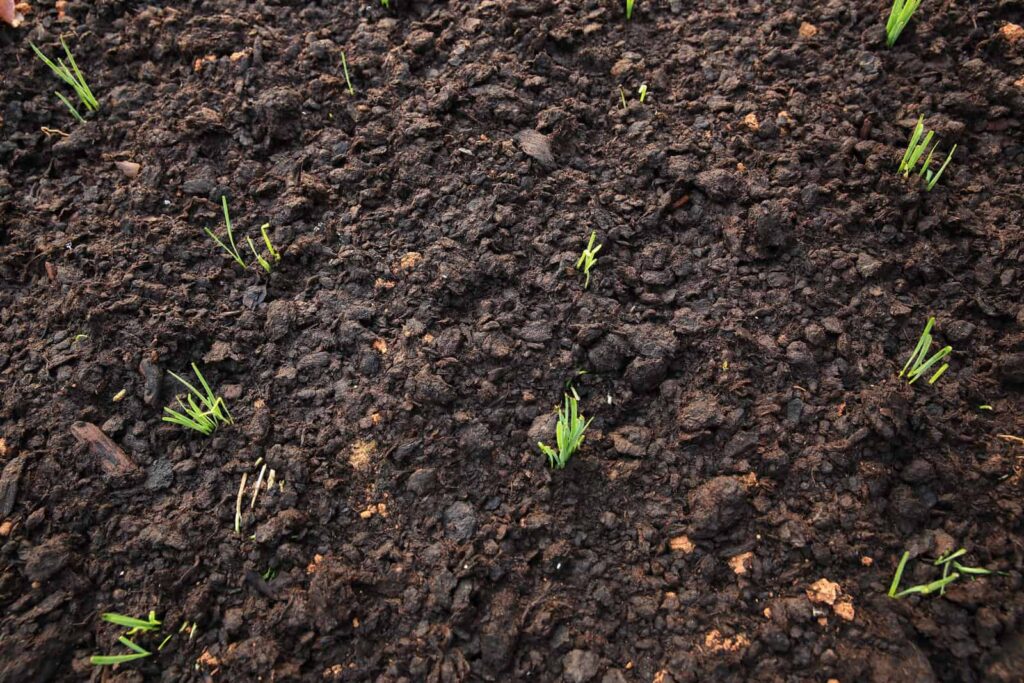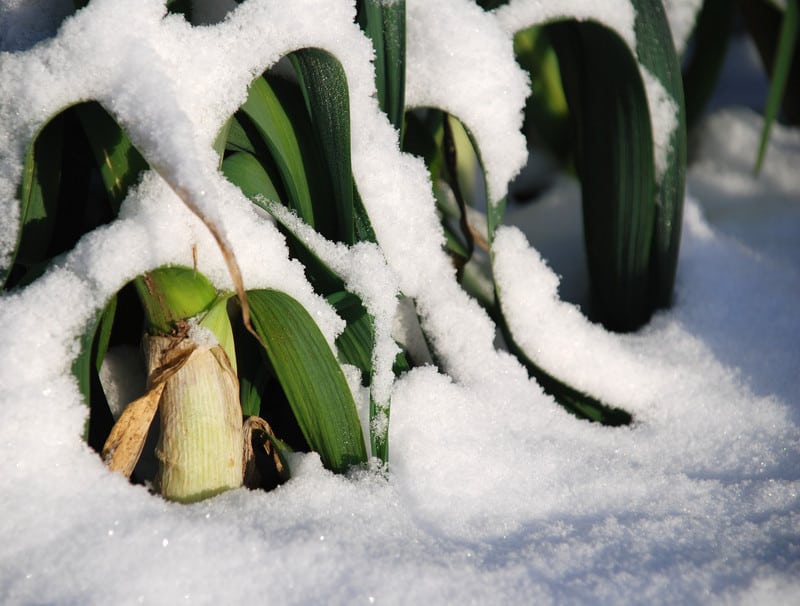Leeks are a cool- and cold-season crop.
There are two types of leeks: short-season leeks and long-season leeks. Long-season leeks have thick, cylindrical stems–and keep long, and short-season leeks that have a thinner stem and don’t keep as well as long-season leeks.
Short-season leeks mature in as few as 70 days. Long-season leeks mature in about 120 to 170 days. Short-season leeks are harvested during the summer. Long-season varieties are harvested from late summer through winter.
Leeks are best started indoors in late winter–about 12 weeks before the last frost–and then transplanted to the garden about a week after the last spring frost.
Good Products for Growing Leeks at Amazon:
- Garden Safe Snail and Slug Bait
- Bonide Sulfur Fungicide
- Monterey BT Caterpillar Killer
- Neem Bliss 100-% Cold Pressed Neem Oil

Leeks are generally classified according to their main season of maturity—in other words, how quickly a variety reaches the harvest stage. Planting times roughly correspond to harvest times although there is some overlap.
There are early, mid-season, and late-season leeks. Early varieties planted in spring will be ready in summer or autumn; mid-season varieties planted in summer will be ready in fall or early winter, and late-season varieties planted in summer or fall will be ready for harvest in late winter or the following spring.
Earlier varieties are generally taller, paler, and have long white shafts; they are also less hardy. Later varieties are shorter and broader with less white shaft and often blue-green leaves; they are also hardier.
When to sow leeks seeds
Where the growing season is long, leeks can be sown in the garden but is preferable to start leeks indoors or in a seedbed where the tiny seedlings do not have to compete with weeds.
Early varieties are best started indoors in late winter or early spring; they should be hardened off before transplanting to the garden.
Mid-season varieties can be started indoors or outdoors in early to mid-spring. If sown outdoors, protect them with cloches.
Late-season varieties can be started indoors or outdoors in late spring.

When to transplant leeks
Transplant leeks to the garden 10 to 15 weeks after sowing when they are about 8 inches (20cm) tall.
Leek size is influenced by spacing. For large plants, space plants 9 inches (23cm) apart. For slimmer leeks, space plant 12 inches (30cm) apart.
Planting leeks
Leeks can be planted on flat ground, but they are most often planted in holes that allow for the blanching of the stems.
Make a hole 6 to 8 inches (15-20cm) deep with a dibble. Place the leek in the hole and water. Allow soil to fall into the hole naturally over time; the soil will blanch the stem in due course.
An alternate method is to create a shallow V-shaped trench about 4 inches (10cm) wide at the bottom; plant the seedlings and then gradually fill the trench with soil to blanch the shafts.
Leeks can adapt to a wide range of soils but do best in humus-rich, well-drained soil. Leeks prefer full sun but will tolerate partial shade.
Begin to harvest leeks when they are useable in size. A layer of mulch will keep leeks in good condition if they are to remain in the garden for winter harvest.
Sowing and planting leeks tips
- Grow leeks from seed or transplants.
- It’s best to start leeks from seed indoors 12 to 4 weeks before the last spring frost; later, set out transplants in spring at least 1 week after the last frost when seedlings are the thickness of a pencil
- In mild-winter regions and where the summers are hot, set out transplants in autumn.
- Sow seed indoors in flats or individual pots; sow seed ⅛ inch (3 mm) deep 1 inch (2.5 cm) apart.
- Set out transplants when seedlings are 6 to 12 inches (15-30 cm) tall; space plants 2 to 4 inches (5-10 cm) apart in trenches 5 inches (13 cm) deep or drop seedlings in a hole about 6 inches deep leaving just one or two leaves above the surface.
- Space rows 12 inches apart.
- Start seeds in a potting mix then transplant them to loose, fertile soil in the garden. Adding aged compost to planting beds in advance of sowing will feed the soil and aid moisture retention.
- The seed will germinate in 8 to 16 days at an optimal temperature of 70°F (21°C) or thereabouts.
- The optimum soil temperature to grow leeks is 70°F (21°C).
- Leeks prefer a pH range of 6.0 to 6.8.
- Grow leeks in full sun for the best yield.
- Keep the soil evenly moist during growth.
- Keep the planting beds free of weeds to avoid competition for moisture and nutrients.
- Avoid planting leeks where onions or garlic have grown recently.
- Fertilize with an organic fertilizer such as fish emulsion at half strength.
- Common pest enemies include thrips and root maggots.
Interplanting: Plant leeks with beets, carrots, celery, garlic onions, and tomatoes.
Container Growing Leeks: Grow leeks in a container at least 10 to 12 inches (25-30 cm) deep.
Leek planting calendar
- 3-4 weeks before last spring frost: start the seed of long-season varieties indoors for fall and winter harvest.
- 6-8 weeks after the last spring frost: transplant seedlings into the garden for winter harvest.

Leeks seed sowing dates
(These dates are for the Northern Hemisphere)
| Average date of the last frost | Planting dates |
| Jan. 20 | Jan. 1-Feb. 1 |
| Feb. 8 | Jan. 1-Feb. 1 |
| Feb. 18 | Jan. 1-Feb. 15 |
| Feb. 28 | Jan. 15-Feb. 15 |
| Mar. 10 | Jan. 25-Mar. 1 |
| Mar. 20 | Feb. 1-Mar. 1 |
| Mar. 30 | Feb. 15-Mar. 15 |
| Apr. 10 | Mar. 1-Apr. 1 |
| Apr. 20 | Mar. 15-Apr. 15 |
| Apr. 30 | Apr. 1-May 1 |
| May 10 | Apr. 15-May 15 |
| May 20 | May 1-May 20 |
| May 30 | May 1-15 |
| June 10 | May 1-15 |

Recommended leek varieties
- ‘American Flag’ (120 days) and ‘Giant Musselburgh’ (150 days) are favorites.
- ‘King Richard’ (75 days) is early maturing.
- ‘Blue Solaise’ is sweet-tasting; ‘Argenta’.
- ‘Unique’, ‘Tardona’, and ‘Nebraska’ are cold hardy.
Botanical Name: Allium porum
Leeks are a member of the Alliaceae also called Lilliaceae family, other members of this family include onions and garlic.
Leeks articles on Harvest to Table:
How to Harvest and Store Leeks
Six Ways to Cook and Serve Leeks
Onion Family Growing Problems Troubleshooting
Garden Planning Books at Amazon:
- Tomato Grower’s Answer Book
- Vegetable Garden Almanac & Planner
- Kitchen Garden Grower’s Guide Vegetable Encyclopedia
- Vegetable Garden Grower’s Guide















